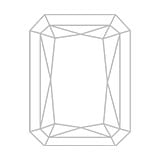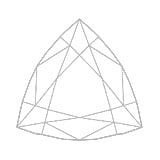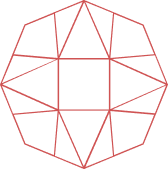Diamonds
The 4 Cs
Before making a diamond purchase, it is advisable to make yourself familiar with a diamond’s 4 Cs – cut, color, clarity and carat weight. Every diamond is graded according to these four features.
Clarity
A diamond'sclarity is very simple to understand. It simply refers to the absence of tiny imperfections within a diamond. These imperfections can be internal or external, known respectively as inclusions or blemishes. A flawless diamond without these imperfections is exceptionally rare and henceforth exceptionally valuable.
Color
Color is one of the most important factors to consider when choosing a diamond. Color presents itself in a diamond as a light hint of yellow or brown. With the exception of fancy color diamonds, most diamonds are graded on their lack of color.
Cut
Of all the 4Cs, cut has the greatest influence on the diamond's overall aesthetic appearance. A diamond's cut is truly the key to the beauty of every diamond. Simply put, it determines how sparkly your diamond will be.
Carat Weight
The word "carat" has a fascinating history, originating in the ancient times when a diamond's weight was measured using the seeds of the carob tree, or carobs. One carat diamond was equal in weight to one carob bean, and hence the name we use today, carat.
Diamond Cut
Diamond cut is wrongly referred to as a diamond shape, but it actually involves a diamond’s proportions, symmetry and polish. Diamond cut is the most important of all four Cs as it determines a diamond’s light performance (its sparkle) and therefore its overall appearance, beauty and value. Although diamond cut can be very demanding to determine and difficult to quantify, there are three components related to diamond cut: brilliance, fire and scintillation. Brilliance is diamond's brightness created by the reflection of light on the inside and outside of a diamond. Fire is dispersed light perceived as flashes of rainbow colors. Fire is most prominent in deem light. Scintillation refers to intense flashes of white and black sparkles created when a diamond or a light source is moved. Scintillation is most obvious in floodlight. A well-cut diamond will maximize the amount of light reflected back out through the diamond's crown and therefore promote brilliance, fire and scintillation. A diamond that is poorly cut, either too shallow or too deep, will allow light to escape from the sides or the bottom, making the diamond appear dull and cloudy. Although diamond cutters sometimes tend to sacrifice a good cut for greater diamond weight, a diamond with a good cut grade and lower clarity, color and carat weight will be more sparkly and more desirable than a poorly cut diamond that performs well in terms of clarity, color or carat weight. GIA has established the following five cut grades for a round brilliant-cut diamond that has 58 facets (57 without the culet): Excellent, Very Good, Good, Fair and Poor.

Ideal / Excellent cut diamonds possess the highest brilliance, fire and scintillation, reflecting almost all the light that enters a diamond and producing exceptional sparkle and vividness. Very good cut diamonds reflect most of the light entering a diamond and produce splendid brilliance, fire and scintillation. Under adequate light very good cut diamonds appear almost as good as excellent ones but at a more affordable price. Good cut diamonds reflect greater part of the light entering a diamond and produce distinguished brilliance, fire and scintillation. An excellent choice in terms of quality-price ratio. Alexanderonly sells diamonds graded from Excellent to Good cut grade.
Diamond Color
White or colorless diamonds are traditionally most popular ones, but there are also very rare and most precious fancy color diamonds ranging from canary yellow to red being the rarest. Color grades for them are diametrically opposed – colorless diamonds are graded according to the absence of color, whereas fancy colored ones are graded according to the intensity of color. Color is the second most important feature of a diamond after the cut. For white diamonds color grades range from D (colorless) to Z (noticeably yellow or brownish). Colorless diamonds are the rarest and most expensive ones. The color grades for white diamonds are as follows:
Colorless Diamonds (D,E,F)
Color Grade D is the highest one. Diamonds with the color grade D are the rarest and most expensive ones, as they are completely colorless.
Color Grade E is just a really tiny step away from perfect. Diamonds with the color grade E are exceptionally transparent and very highly priced.
Color Grade F refers to diamonds with minute microscopic traces of color that are extremely hard to detect by diamond experts. F graded diamonds are highly priced.
Near Colorless Diamonds (G, H, I, J)
Color Grade G refers to diamonds that are nearly colorless, but still extremely rare. Such diamonds have almost completely indiscernible color when compared to colorless diamonds.
Color Grade H comprises nearly colorless diamonds that display just an extremely tiny hint of color when compared to colorless diamonds. They are an excellent value for money.
Color Grade Irefers to nearly colorless diamonds with very slight hints of color in comparison to completely colorless diamonds. Those minute traces of color are invisible to the unaided eye.
Color Grade Jrefers to diamonds that exhibit tiny traces of color when compared to colorless diamonds. Still high in quality, these diamonds are commonly found in the vast majority of jewelry.
Diamond Fluorescence
Trace minerals inside diamonds cause them to emit a soft colored light (usually blue) under ultraviolet light. 30% of all diamonds exhibit fluorescence and 95% of it is blue, although (very rarely) fluorescence can be yellow, orange, red or other colors. Fluorescence is graded as Very Strong, Strong, Medium, Faint and None.
Fluorescence is believed to lower the color and clarity of colorless diamonds (D-F), making them cloudy, hazy or oily, which results in price reduction. On the other hand, diamonds that exhibit slightly yellow tint (K-M) may appear to have higher color grade, as yellow is neutralized by blue fluorescence. Moreover, in rare cases when fluorescence is yellow, it can intensify the color of faint yellow diamonds.
In 1997, GIA conducted a study on the effect of ultraviolet light on a diamond’s appearance. The study participants were both ordinary, untrained observers and trained gemologists/jewelry professionals. Although fluorescence is the topic that has continually created confusion and debate, the study results showed that fluorescence was not an issue when buying diamonds, as it did not have negative influence of the overall diamond appearance. The GIA study confirmed that “strongly blue fluorescent diamonds were perceived to have a better color appearance when viewed table-up” in comparison to non-fluorescent ones, despite previous conviction that strong and very strong fluorescence should be avoided. Only less than 0,2 % of diamonds submitted to the GIA appeared milky or oily due to fluorescence.
Having taken into consideration all of the above, fluorescence should be only a matter of personal preference when buying a diamond. However, if your intention is to buy diamonds as an investment for the future resale, bear in mind that fluorescence still tends to affect a diamond price, no matter if such practice is justified or not.
Alexander sells colorless and near colorless diamonds only. (colors D to J).
Diamond Clarity
Diamond clarity grading establishes the visibility, number, position and the size of diamond imperfections that appear during a diamond formation and to what extent those imperfections affect the overall diamond appearance. These imperfections are usually referred to as inclusions and blemishes, inclusions being the internal imperfections and blemishes being the external, surface ones, such as nicks and scratches. Although the least important of all four C diamond features, higher diamond clarity demands a higher price. Diamonds are inspected for clarity under 10x magnification and the grades range as follows:
Flawless diamonds (FL) have absolutely no inclusions or blemishes visible under 10x magnification. They are extremely rare and valuable.
Internally Flawless (IF) diamonds possess no visible inclusions under 10x magnification.
Very, Very Slightly Included (VVS1) diamonds have minute inclusions that are hard to detect by diamond experts under 10x magnification when viewed from the bottom of a diamond.
Very, Very Slightly Included (VVS2) diamonds have a slightly lower clarity grade than VVS1 diamonds. VVS2 diamonds have minute inclusions that are hard to detect by diamond experts under 10x magnification when viewed face up.
Very Slightly Included (VS1) diamonds possess minor inclusions that take some time and effort to be visible only under 10x magnification and only when inspected by a diamond expert.
Very Slightly Included (VS2) diamonds possess minor inclusions visible only to a diamond expert and only under 10x magnification. VS2 diamonds have more inclusions than VS1 diamonds and those inclusionsare slightly bigger or more easily discerned.
Slightly Included (SI1) diamonds possess inclusions that can be easily noticed by a skilled grader under 10x magnification. Such inclusions are invisible to the naked eye.
Slightly Included (SI2) diamonds have inclusions that are easily visible under 10x magnification and tothe naked eye after a close inspection.
Alexander only sells diamonds graded from IF to SI2 clarity grade.
Diamond Carat Weight
A carat is a standard measure for diamond’s weight. One carat equals 200 milligrams, a weight of a paper clip. Each carat has 100 points; thus diamonds that weigh less than one carat may be expressed in points rather than carats (80 points equal 0.80 carat), whereas diamonds over a carat are described with carats and decimals (e.g. 1.05 carats).
Carats are not to be confused with karats, which is a measure of the proportion of gold in an alloy. The term carat originates from the word “carob”, as diamonds were once measured with the help of tiny and uniform carob seeds serving as diamonds’ counterbalance.
Since large diamonds are very rare to find, diamonds with larger carat weight are more expensive than those lighter ones, provided that cut, color and clarity are the same. However, diamond carat weight is not the accurate representation of diamonds’ size, as lighter but well-cut diamonds may appear bigger and sparklier than poorly cut diamonds with a greater carat weight. Also, some ring settings tend to be more flattering to a diamond and the same diamond may look more massive on small than on long fingers.
Diamond Shapes
A diamond shape is sometimes wrongly referred to as a diamond cut. Diamonds come in many shapes; round brilliant cut being the most popular one, as it exhibits the maximum brilliance, fire and scintillation. All other diamond shapes except round are known as fancy diamond shapes.
In 1919, Marcel Tolkowsky, a renowned jeweler, set the standards for the modern round brilliant cut diamonds, also called the American Ideal Cut. A round brilliant cut diamond has 58 facets (57 without the culet), 33 facets on the crown and 25 on the pavilion. The perfect version of a round brilliant cut diamond exhibits the Hearts and Arrows phenomenon. Such diamonds are cut with utmost precision and possess superior characteristics; their facets are ideally aligned, displaying the pattern of eight hearts (viewed from the bottom) and eight arrows (viewed from the top) visible under a special magnification.
Apart from the brilliant cut, there are also step cut diamonds and mixed cuts that are the combination of the brilliant cut and a step cut. Most of fancy shaped diamonds do not have the culet. Their pavilion facets form the edge called the keel line.

Round Diamonds
A round brilliant cut diamond has 58 facets (57 without the culet), 33 facets on the crown and 25 on the pavilion. The perfect version of a round brilliant cut diamond exhibits the Hearts and Arrows phenomenon. Such diamonds are cut with utmost precision and possess superior characteristics; their facets are ideally aligned, displaying the pattern of eight hearts (viewed from the bottom) and eight arrows (viewed from the top) visible under a special magnification.
BROWSE
Emerald Cut Diamonds
A vast open table, rectangular shape and truncated corners are the hallmarks of Emerald cut diamonds. As the name says, Emerald cut was first invented for cutting emeralds, but then it proved to be suitable for diamonds and other gems too. Usually recommended length-to-width ratio for Emerald cuts is 1.50-1.75. Emerald cut diamonds are the symbol of elegance and sophistication.
BROWSE
Asscher Cut Diamonds
The Asscher cut diamond was invented in 1902 and named after its creator Joseph Asscher, the owner of the Asscher Diamond Company in Amsterdam. Asscher cut diamonds are almost identical to Emerald cut ones, but only square, hence the alternate name Square Emerald cut diamonds. Similarly to other step cut diamonds, inclusions are highly visible in Asscher cuts, thus it is important to acquire a diamond of VS clarity or better. Asscher cut diamonds appear more brilliant than Emerald cut ones due to their higher crown, bigger facets and smaller table. The ideal length to width ratio for Asscher cuts is 1.00.
BROWSE

Princess Cut Diamonds
Princess cut diamonds owe their popularity to the immense sparkle and fire, as they provide the maximum brilliance from the square cut. They have 76 facets that additionally contribute to their alluring luster. Princes cut is also the most convenient cut for carat weight saving. Four pointed corners should be secured to prevent diamond chipping and the color grade should be paid special attention to, as the traces of color may be visible in the diamond corners. The ideal length to width ratio for square Princess cut diamonds is between 1 and 1.05. For those that prefer slightly rectangular Princess cut diamonds, the length to width ratio should be between 1.10 and 1.20. Princess cut diamonds look best on long fingers.
BROWSE
Radiant Cut Diamonds
The Radiant cut was invented by Henry Grossbard in 1977. Radiant cut diamonds resemble Emerald cut and Asscher cut diamonds in shape, but unlike them, Radiant cuts possess the brilliance of a round brilliant cut diamond, which makes the inclusions slightly less visible. The usual number of facets is 70 and the length to width ratio is to 1.2-1.5. Radiant cut diamonds are the symbol of liveliness and exuberant personality.
BROWSE
Oval Shaped Diamonds
Oval shaped diamonds were first created by Lazare Kaplan in the 1960's. Lazare Kaplan was a cousin of famous Marcel Tolkowsky, the creator of the ideal cut for round brilliant cut diamonds. There is a great demand for Oval shaped diamonds and their popularity comes from the unique shape in combination with the brilliance and fire of a round brilliant cut diamond. Oval shaped diamonds, along with other elongated fancy shaped diamonds, may display a bow-tie effect to a certain degree. A bow-tie effect is the result of light leakage due to misaligned facets, which creates a visual impression of dark area that runs right to left across the center of a diamond resembling a man's bow tie. A standard number of facets for Oval shaped diamonds is 56 and the typical length-to-width ratio is between 1.33 and 1.66. Oval shaped diamonds can make the fingers longer and slimmer, conveying the feel of sophistication and refinement.
BROWSE

Pear Shaped Diamonds
Pear shaped diamonds (also called teardrop diamonds) have one pointed and one rounded end, along with the sparkle of a round brilliant cut diamond. Similarly to round brilliant cuts, Pear shaped diamonds usually have 56 facets and the standard length-to-width ratio is between 1.45 and 1.75. When buying a Pear shaped diamond, one should avoid intense bow-tie effect and uneven diamond shoulders.
BROWSE
Heart Shaped Diamonds
The traditional symbol of love and romance, Heart shaped diamonds look like Pear shaped ones with a cleft on top. Well cut Heart shaped diamonds require exceptional craftsmanship to produce perfect symmetry between the halves and a clearly visible cleft between them. Heart shaped diamonds with small carat weight may appear even smaller when set, thus, a three prong setting and a bezel setting are recommended. The color grade should also be taken into consideration, as traces of color may be visible in the corners of diamonds graded J and beyond. The standard length to width ratio is between .90 and 1.10.
BROWSE
Marquise Shaped Diamonds
Marquise shaped diamonds, also called navette, which is a French word for “little boat”, are specially cut to preserve the carat weight and retain the brilliance of a round brilliant cut diamond. The Marquise cut was invented on request of King Louis XIV of France who wanted to capture the seductive smile and perfectly shaped lips of his mistress Marquise de Pompadour, hence the name. The boat shape of these diamonds creates the illusion of greater size and makes the fingers longer and slimmer. Marquise shaped diamonds look good as both central and side stones. The standard length to width ratio for classic cut Marquise shaped diamonds is between 1.75 and 2.25.
BROWSE
-

Cushion Shaped Diamonds
Cushion shaped diamonds look like a pillow (or cushion) with their rectangular or square shape with rounded corners, hence the name. They are usually described as the combination of the Old Mine cut and the modern Oval cut. Cushion shaped diamonds were extremely popular until the early 20th century. There are many different modified kinds of Cushion shaped diamonds, a popular one being the Cushion Modified Brilliant that possesses enhanced sparkle due to a row of extra facets on the pavilion. The addition of extra facets serves to produce the so-called “sparkling water” or “crushed ice” effect, which provides the diamonds with greater scintillation. The typical length to width ratio for square Cushion shaped diamonds is between 1.00 and 1.05. If you prefer a slightly rectangular shape, the length to width ratio should be 1.10 - 1.20.
BROWSE -

Trilliant cut
Trilliant cut (also called Trillion or Trillian) diamonds are triangular in shape and have three sides that may be curved or uncurved. This cut was first introduced by the Asscher brothers in Amsterdam and then patented by the Henry Meyer Diamond Company of New York in 1962. Trilliant cut gradually became the term for all triangular gems. The shape and brilliance of Trilliant cut diamonds can be simply stunning, if the symmetry and proportions are perfect, which requires exceptional craftsmanship. The depth of cut is also of special importance in achieving sharp brilliance and fire. Trilliant cut diamonds can be both solitaires or side stones and the typical number of facets is between 31 and 50. The standard length to width ratio is 1:1, with curved sides for solitaires and uncurved cut for side diamonds.

Baguette cut
Long and rectangular, Baguette cut diamonds are named after the French word “baguette” meaning “a long rod”. They became popular during the Art Deco and Art Nouveau movements and are usually used as side stones, as their typical carat weight is less than one carat. Baguette cut diamonds have only 14 facets and their ideal length to width ratio is 1.5 to 1.0. High clarity grade is also important, as inclusions tend to be easily visible. Baguette cut diamonds can be Straight Baguettes with a narrow rectangular cut or Tapered Baguettes with uneven short sides.








